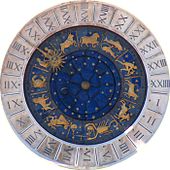| Astrology |
|---|
 |
| Background |
| Traditions |
| Branches |
| Astrological signs |
| Symbols |
In astrology, sidereal and tropical are terms that refer to two different systems of ecliptic coordinates used to divide the ecliptic into twelve "signs". Each sign is divided into 30 degrees, making a total of 360 degrees.[1] The terms sidereal and tropical may also refer to two different definitions of a year, applied in sidereal solar calendars or tropical solar calendars.
While sidereal systems of astrology calculate twelve zodiac signs based on the observable sky and thus account for the apparent backwards movement of fixed stars of about 1 degree every 72 years from the perspective of the Earth due to the Earth's axial precession, tropical systems consider 0 degrees of Aries as always coinciding with the March equinox (known as the spring equinox in the Northern Hemisphere) and define twelve zodiac signs from this starting point, basing their definitions upon the seasons and not upon the observable sky wherein the March equinox currently falls in Pisces due to the Earth's axial precession.[2][3][4] These differences have caused sidereal and tropical zodiac systems, which were aligned around 2,000 years ago when the March equinox coincided with Aries in the observable sky, to drift apart over the centuries.[5][6][7]
Sidereal astrology accounts for the Earth's axial precession and maintains the alignment between signs and constellations via corrective systems known as ayanamsas (Sanskrit: 'ayana' "movement" + 'aṃśa' "component"), whereas tropical astrology, to reiterate, is based upon the seasonal cycle of the Northern hemisphere and does not take axial precession into consideration. Though tropical astrology typically considers the zodiac of the Northern Hemisphere to be applicable without change to the Southern hemisphere, a small number of tropical astrologers modify the zodiac to reflect seasons in the Southern hemisphere, taking Libra as the sign that coincides with the spring equinox instead of Aries.[3][8][9]
Ayanamsa systems used in Hindu astrology (also known as Vedic astrology) include the Lahiri ayanamsa and the Raman ayanamsa, of which the Lahiri ayanamsa is the most widely used.[10] The Fagan-Bradley ayanamsa is an example of an ayanamsa system used in Western sidereal astrology.[10] As of 2020, sun signs calculated using the Sri Yukteswar ayanamsa were around 23 degrees behind tropical sun signs.[8] Per these calculations, persons born between March 12 – April 12, for instance, would have the sun sign of Pisces.[8] Per tropical calculations, in contrast, persons born between March 21 – April 19 would have the sun sign of Aries.[11]

- ^ "The Tropical, Sidereal & Constellational Zodiacs: the Power of World View". www.renaissanceastrology.com. Archived from the original on March 20, 2022. Retrieved July 29, 2020.
- ^ Subramanian, Vijaya. "Sidereal and Tropical Zodiac – Vijaya Jyoti". Archived from the original on August 7, 2020. Retrieved July 29, 2020.
- ^ a b galacticcenter (October 10, 2016). "What is Vedic Astrology?". Galactic Center with Joni Patry. Archived from the original on August 7, 2020. Retrieved July 29, 2020.
- ^ Taya. "Understanding Sidereal Charts". astro-charts.com. Archived from the original on August 7, 2020. Retrieved July 29, 2020.
- ^ Subramanian, Vijaya. "Sidereal and Tropical Zodiac – Vijaya Jyoti". Archived from the original on August 7, 2020. Retrieved July 29, 2020.
- ^ galacticcenter (October 10, 2016). "What is Vedic Astrology?". Galactic Center with Joni Patry. Archived from the original on August 7, 2020. Retrieved July 29, 2020.
- ^ Vallée, Guylaine (March 1, 2020). "What's Your Vedic Astrological Sign?". Birla Vedic Center. Archived from the original on August 7, 2020. Retrieved July 29, 2020.
- ^ a b c Vallée, Guylaine (March 1, 2020). "What's Your Vedic Astrological Sign?". Birla Vedic Center. Archived from the original on August 7, 2020. Retrieved July 29, 2020.
- ^ Mystic (October 20, 2020). "The Real Southern Hemisphere Astrology". Mystic Medusa Astrology. Retrieved February 23, 2023.
- ^ a b "Ayanamshas in Sidereal Astrology". www.astro.com. Archived from the original on August 7, 2020. Retrieved July 29, 2020.
- ^ "Zodiac Sign Dates: What Are The Dates for Every Star Sign?". Astrostyle: Astrology and Daily, Weekly, Monthly Horoscopes by The AstroTwins. September 28, 2016. Archived from the original on August 7, 2020. Retrieved July 29, 2020.